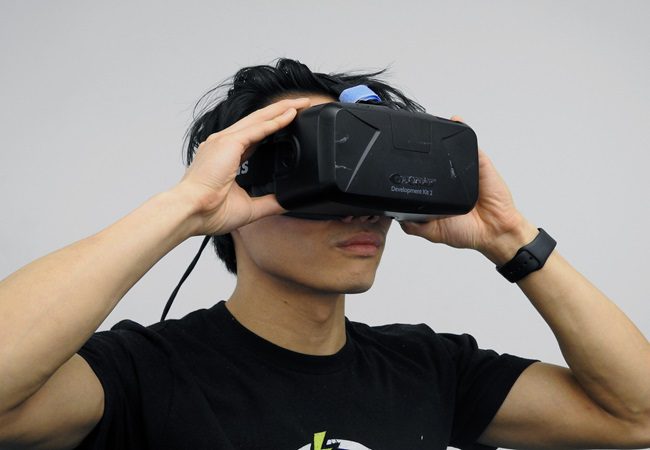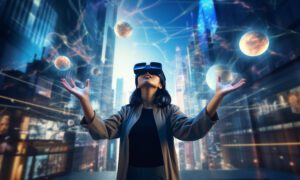Introduction:
In the dynamic realm of technology, Virtual Reality (VR) has transcended the boundaries of traditional design, ushering in a new era of immersive experiences. Moreover, designing for Virtual Reality presents a unique set of challenges and opportunities that demand a thoughtful approach to create compelling and user-friendly environments. In this exploration, we will delve into the best practices and challenges associated with designing for Virtual Reality, navigating the intricate landscape where creativity meets technological innovation.
Understanding the Immersive Design Paradigm:
User-Centric Design Principles:
At the core of designing for Virtual Reality is the principle of user-centricity. Every aspect of the VR experience should revolve around the user, aiming to provide an immersive and intuitive journey. Short sentences guide the user seamlessly through the virtual environment, ensuring that information is easily digestible, and transitions smoothly.
Spatial Awareness and Navigation:
Spatial awareness is a crucial aspect of VR design. To elaborate, users must feel a sense of presence and orientation within the virtual space. Additionally, short, concise cues guide users through the environment, promoting a seamless navigation experience. Moreover, transitioning between different areas or interactions should feel natural, reducing the risk of disorientation or discomfort.
Intuitive Interaction Models:
VR environments call for intuitive interaction models that mimic real-world actions. Short prompts and clear instructions guide users on how to interact with objects or navigate the virtual space. Designers should prioritize simplicity, ensuring that users can grasp interactions effortlessly, even if they are new to the VR experience.
Best Practices for Visual Design:
Optimal Graphics and Performance:
Visual design in VR hinges on optimal graphics and performance. Short loading times and high-quality graphics contribute to a smooth and immersive experience. Transitioning between scenes should be seamless, minimizing any disruptions that could break the user’s sense of presence.
Consistent Aesthetics and Branding:
Maintaining a consistent aesthetic and branding is essential for VR experiences. Short bursts of branded elements and cohesive visual language enhance recognition and familiarity. Consistency in design creates a cohesive narrative, making the virtual environment more engaging and memorable for users.
Attention to Detail:
In VR, attention to detail is paramount. Short, crisp details enhance the realism of the environment, creating a more immersive experience. Transitioning between scenes should be accompanied by subtle details, such as lighting changes or spatial sound cues, to maintain a sense of continuity and presence.
Overcoming Design Challenges in Virtual Reality:
Motion Sickness and Discomfort:
One of the primary challenges in designing for VR is mitigating motion sickness and discomfort. Short, frequent breaks in transitions help reduce the risk of nausea. Designers should avoid abrupt movements or rapid scene changes, allowing users to acclimate to the virtual environment gradually.
Hardware Limitations:
The diverse range of VR hardware introduces a challenge in creating universally compatible designs. Additionally, short loading times and optimized graphics cater to a variety of devices, ensuring a seamless experience across different VR platforms. To elaborate further, transitioning between hardware specifications requires adaptive design practices to maintain a consistent user experience.
Accessibility Considerations:
Designing for inclusivity is a challenge in any medium, and VR is no exception. Short, clear instructions and intuitive interactions contribute to an accessible VR experience. Transitioning between different accessibility features seamlessly integrates diverse user needs, promoting an inclusive virtual environment.
The Role of Storytelling in VR Design:
Immersive Narratives and Story Arcs:
Storytelling takes on a new dimension in VR design. Short narrative arcs and immersive storytelling techniques guide users through the virtual space, creating a more engaging and memorable experience. Transitions between different story elements should be seamless, allowing users to remain immersed in the narrative.
User Agency and Interaction:
VR design empowers users with a sense of agency within the virtual environment. Moreover, short prompts and interactive elements allow users to actively shape their experience. Additionally, transitions between interactive elements should be smooth, providing users with a seamless and responsive journey.
Emotional Engagement and Presence:
Emotional engagement is a key element in VR design. Additionally, short, impactful moments contribute to the emotional resonance of the experience. Furthermore, transitions between emotional beats should be carefully orchestrated, ensuring a smooth flow that enhances the user’s sense of presence and connection to the virtual world.
SEO Optimization for VR Designers:
Keywords for Virtual Reality Design:
When optimizing content for search engines, VR designers should incorporate relevant keywords. Short, descriptive phrases about VR design practices and challenges enhance discoverability. Transitioning between keywords naturally within the content ensures that it aligns with the search intent of users interested in VR design.
High-Quality Visual Content:
Search engines prioritize high-quality visual content, and VR design is no exception. Short, engaging visual elements and transitions within the content can enhance its SEO value. Integrating multimedia, such as short videos showcasing VR designs, contributes to a more comprehensive and appealing presentation.
User-Centric SEO Strategies:
SEO strategies for VR design should be user-centric. Short, user-friendly meta-descriptions and titles guide users to relevant content. Transitioning between SEO elements, such as headers and bullet points, creates a well-organized structure that improves readability and user experience.
Future Trends in VR Design:
Enhanced Interactivity with AI:
The future of VR design lies in enhanced interactivity facilitated by Artificial Intelligence (AI). Furthermore, short, dynamic interactions powered by AI algorithms provide users with more personalized and responsive experiences. Additionally, transitioning between AI-driven elements ensures a fluid and adaptive user journey within the virtual space.
Integration with Augmented Reality:
The convergence of Virtual Reality and Augmented Reality is a trend that designers should anticipate. Short, seamless transitions between virtual and real-world elements create a more integrated and immersive experience. Designing for this convergence requires a careful balance to maintain the coherence of the overall design.
Evolving Hardware Capabilities:
As VR hardware capabilities evolve, designers must adapt to shorter loading times and improved graphics. Additionally, transitioning between different hardware specifications becomes more seamless, providing designers with new opportunities to create more complex and visually stunning virtual environments.
Conclusion:
Designing for Virtual Reality presents a captivating blend of best practices and challenges, requiring a strategic and creative approach. Furthermore, short, user-centric design principles, optimal visual elements, and a keen understanding of VR’s unique challenges are essential for crafting immersive experiences. As technology continues to advance, designers will navigate the evolving landscape of VR, embracing new trends and overcoming challenges to shape the future of virtual experiences. In the realm of Virtual Reality design, the journey is as important as the destination; each transition contributes to a more seamless and engaging user experience.



































